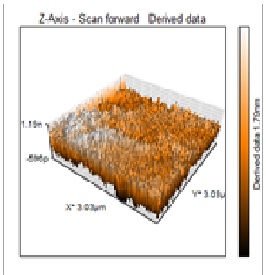Nanosystems: Phys. Chem. Math., 2023, 14 (6), 633–643
Study of the electrical and electronic properties of crystalline molybdenum disulfide (MoS2-3R) semiconductor nano using alternating current (AC) measurements
Hussein Alhussein – University of Aleppo, Syria
Jamal Qasim AlSharr – University of Aleppo, Syria
Sawsan Othman – University of Aleppo, Syria
Hassan AlKhamisy – University of Aleppo, Syria
Corresponding author: Hussein Alhussein, husianphy990@gmail.com
DOI 10.17586/2220-8054-2023-14-6-633-643
ABSTRACT MoS2 nanostructures were prepared using the hydrothermal method by reacting ammonium heptamolybdate tetrahydrate ((NH4)6Mo7O244H2O) with citric acid monohydrate (C6H8O7H2O) in distilled water with the presence of sodium sulfide (Na2S). The surface structure studies of MoS2 showed that the size of the surface clusters of the studied tablet is of the order of 50 – 100 nm. Using measurements (Zetasizer Nano Series), we found that the particle sizes ranged from 150 – 350 nm. Alternating current (LCR) measurements were made for (tablet-MoS2) under a constant temperature T = 10 °C. Measurements of the parallel electrical capacitance (Cp) in terms of frequency (F) of tablet-MoS2 showed a sharp drop in the value of the electrical capacitance (Cp) with an increase in frequency within the range 20 Hz – 16 kHz. It is shown that the series capacitance increased with the increase of the applied potential.
KEYWORDS MoS2-3R, atomic force microscopy (AFM), LCR measurements, electrical capacitance, Zetasizer Nano Series
FOR CITATION AlHussein H., AlSharr J., Othman S., AlKhamisy H. Study of the electrical and electronic properties of crystalline molybdenum disulfide (MoS2-3R) semiconductor nano using alternating current (AC) measurements. Nanosystems: Phys. Chem. Math., 2023, 14 (6), 633–643.
[In Russian] Х. Аль-Хусейн, Дж. Аль-Шарр, С. Отман, Х. аль-Хамиси
Исследование электрических и электронных свойств кристаллического нанополупроводника дисульфида молибдена (MoS2-3R) с использованием измерений переменного тока (AC)
АННОТАЦИЯ Гидротермальным методом получены наноструктуры MoS2 путем взаимодействия тетрагидрата гептамолибдата аммония ((NH4)6Mo7O244H2O) с моногидратом лимонной кислоты (C6H8O7H2O) в дистиллированной воде в присутствии сульфида натрия (Na2S). Исследования структуры поверхности MoS2 показали, что размер поверхностных кластеров исследуемой таблетки составляет порядка (50-100) нм, а с помощью измерений (серия Zetasizer Nano) мы установили, что размеры частиц находились в пределах (150-350) нм. Также измерения переменного тока (LCR) проводились для таблетки-MoS2 при постоянной температуре (Т = 10)°С. Также измерения параллельной электрической емкости (Cp) в пересчете на частоту (F) (таблетка-MoS2) показали резкое падение значения электрической емкости (Cp) с увеличением частоты в диапазоне [20Гц-16кГц ], Cs уменьшается с увеличением потенциала. Показано, что последовательная емкость увеличивается с увеличением приложенного потенциала.
КЛЮЧЕВЫЕ СЛОВА (MoS2-3R), атомно-силовая микроскопия (АСМ), измерения LCR, электрическая емкость, серия Zetasizer Nano.
